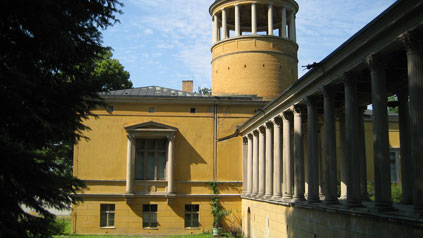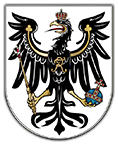
This renovated farmhouse close Lindstedt was acquired by Frederick William IV in 1828, who rebuilt it as a palace from 1859. The palace along Lindstedter Chaussee in Potsdam has a very unique architectural style. The building was designed to resemble a two-story, asymmetrical Roman villa with a colonnade to the garden. Architects Ludwig Ferdinand Hesse, Ludwig Persius and Friedrich August Stüler wanted to create a retirement retreat in Potsdam for the monarch in the style of villa. Friedrich August Stüler was a Prussian architect and authoritative architect of his time, while Ludwig Persius was a student of Karl Friedrich Schinkel and together had great influence over construction design at the time. Along with Peter Joseph Lenne, they were some of the leading architects in Prussia.
One of the King’s main goals was to create a landscape in Potsdam that combined architecture and nature. He commissioned stunning palace buildings next to the Lindstedt Palace that incorporated gardens with plants that were largely found in the vicinity of Potsdam. These buildings followed in the architecture tradition of classical antiquity (Greco-Roman antiquity) and the Italian Renaissance from the fourteenth to sixteenth centuries. At the same time, the construction of the Lindstedt Palace is simple and straight-forward in its design and styling. Much of the work carried out on the palace started after a long planning period before the death of Frederick William IV in 1861. The King’s brother and successor, William I, handed over development of the palace to Ludwig Ferdinand Hesse.
Lindstedt Palace in Potsdam has many features that resemble a temple, including a round tower and façade with long columns. Steps also lead up to the palace from the road. With his death in 1861, the palace was never used as a retirement home for the as originally planned. It remained in the hands of the House of Hohenzollern. Peter Joseph Lenné was originally commissioned to transform 33 acres of land around the palace into a garden, but from 1858 this was limited to just the borders of the two-hectare Gutgartens. He designed a garden in the style of ancient villa gardens. Although the garden only a small part of what was originally envisioned, it still a strong sense of royal elegance. The palace is a listed building and was declared a UNESCO World Heritage Site in 1999. It is now a wonderful setting for lectures, small concerts, receptions and readings. The Lindstedt Palace is located in Potsdam on Lindstedter Chaussee, close to the Neues Palais (New Palace) and Sanssouci Park. Access to the palace is via the portico and guided tours of the castle and the grounds are available.
Events in Potsdam
ticket sales
Music Festival in PotsdamThe Music Festival in Potsdam will be held again in June. This year's theme "Music and gardens" ubiquitous. So even on the opening day in June. Interesting and unique you can take guided tours and visits to many different places. For those interested there is an Opera Workshop.
TICKETSDetails about the Music Festival in Potsdam can be found here.
The concert on the eve and Night of the Palaces in PotsdamThe Park of Sanssouci and Sanssouci Palace with its terraced vineyards and the New Palace are undisputedly the most important monuments in Potsdam, therefore provides the Night of the Palaces as an excellent temporal orientation, to learn more about the state capital of Brandenburg.
TICKETSDetails about the Night of the Palaces can be found here.



